At reproductive age, women in the middle of each cycle have fertile days. It is during this period that the conception of a child can occur. Various methods and formulas allow you to correctly calculate such a window.
Record content:
- 1 Definition
- 2 Meaning
- 3 How and under what conditions is it manifested
- 4 Symptoms
- 5 Factors
-
6 How to calculate
- 6.1 Ovulation test
- 6.2 Drawing up a calendar
- 6.3 According to the state of cervical secretion
- 6.4 By measuring basal temperature
- 6.5 Using ultrasound results
- 7 Fertility videos
Definition
The fertile window is the period of time at which the chances of conceiving a child are close to 100%.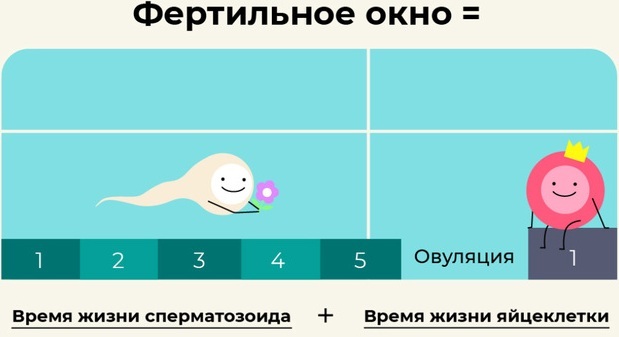 During this period, all sexual intercourse without protective equipment leads to pregnancy. The most reliable and successful moments are considered 2 days before and after ovulation, as well as the day the egg is ejected from the follicle.
During this period, all sexual intercourse without protective equipment leads to pregnancy. The most reliable and successful moments are considered 2 days before and after ovulation, as well as the day the egg is ejected from the follicle.
Meaning
The ability to calculate women's fertile days allows you to:
- choose the right contraception;
- planning a pregnancy;
- identify malfunctions of reproductive function.
How and under what conditions is it manifested
Estrogen in the female body stimulates the ovaries to produce an egg every month. The moment of female fertility occurs during ovulation and lasts another day after it. During this period, a mature egg, escaping from the follicle, moves through the tube to the woman's reproductive organ for her further fertilization with a sperm.
When an egg leaves the follicle, if she is lucky enough to become fertilized, progesterone appears in the body. This hormone helps the uterine lining to thicken.
Along with this, it also slightly raises the body temperature. In the absence of fertilization, the egg decays, and the hormonal background calms down. After 12-17 days, menstruation begins, which removes the remnants of the gamete from the body along with the blood.
It happens that ovulation does not occur in every female cycle. This can be due to age or body characteristics. This process is also called anovulatory. Cycles with a similar pattern are more common in women over 35. At this age, because of this, it is much harder to get pregnant on your own.
For guaranteed fertilization, not only a high-quality sperm is required, but also a fully capable egg. It shouldn't be overripe. Such a defect with her sometimes occurs due to a recent disease of the genital organs or the past anovulatory cycle.

Those women who rely on a fertile prognosis to prevent pregnancy should be wary of re-ovulation. After all, it can also sometimes happen, especially in some women who experience constant sexual attraction throughout their lives. After all, increased libido provokes maturation and the release of another egg.
There are 4 stages of female fertility:
- Early, starting from the first menstruation and lasting up to 20 years. It is characterized by a floating cycle and an unstable hormonal background. During this period, girls can become pregnant from any sexual intercourse.
- Average reproductive (20-40 years old) with a stable hormonal state and constant menstruation. This time is considered the most suitable time for conceiving and bearing a child.
- Late (40-46 years old), with her, pregnancy still comes easily, but it is already more difficult to tolerate.
- Fading (46-60 years old), in which ovulation becomes almost elusive. The pregnancy that has occurred during this period is always carefully supported and monitored by doctors.
The female cycle consists of the following phases:
- safe, from the end of menstruation to ovulation;
- fertile, coinciding with the release of a mature egg;
- infertile, occurring immediately after ovulation.
Symptoms
Indirect signs of ovulation are:
- increased libido;
- the appearance of acne;
- excessive oily skin and hair;
- severe breast tenderness;
- malaise and pulling pains in the lower abdomen;
- too sticky and copious cervical mucus.
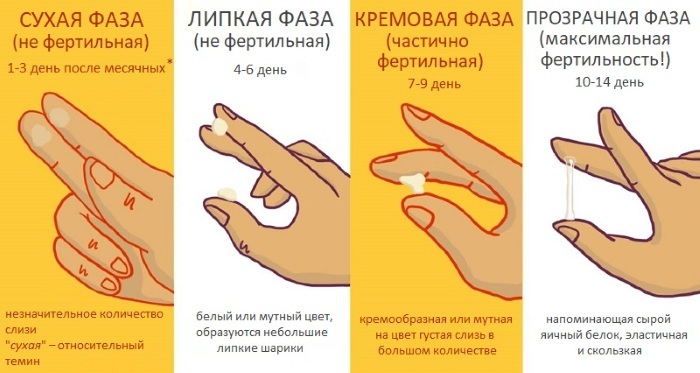
Fertility window - this concept defines the possible days for conceiving a child, has a precise and definite time frame. A woman becomes pregnant only when her mature cell leaves the follicle. This process is called ovulation.
A woman's fertility depends on the circumstances that affect her ability to conceive. High fertility is manifested in the fact that pregnancy occurs easily and at any time (during ovulation), without artificial auxiliary methods.
Factors
The reasons that affect the fertile phase are:
- high viability of sperm (up to 7 days);
- stress;
- loads;
- age;
- climate change;
- internal structure of the vagina;
- chromosome abnormalities;
- low activity of male germ cells;
- unstable mental state;
- drug therapy;
- early menopause;
- hormonal disorder;
- the use of pain relievers with caffeine;
- non-infectious diseases of the female genital area;
- adhesions of tissues or pipes;
- infectious brain diseases;
- excess weight;
- insufficient drinking regime;
- the condition of the fallopian tubes;
- oocyte quality.
Excessive body weight of a woman negatively affects the work of the ovaries. And with its lack, there is a poor release of hormones. Constant fluctuations in weight generally lead to a decrease in fertility.
In order for the reproductive system to function correctly, a woman's nutrition must be of high quality and balanced.
Therefore, abundance is important in the body:
- microelements;
- vitamins;
- carbohydrates;
- proteins;
- fat.
Addictions, such as smoking and alcohol abuse, also severely harm fertility. Their chemical compounds greatly age and wear down the female reproductive system. According to research, the ovaries of 30-year-old girls who smoke and drink are 10 years older.
Female age, over 35 years old, greatly reduces not only fertility, but also the effectiveness of methods of combating infertility. Therefore, gynecologists recommend trying to get pregnant for younger girls.
Those who want to get pregnant need to constantly protect themselves from depression and strong feelings. After all, such conditions always lead to menstrual irregularities and hormonal imbalances.
Experts believe that the following will help get rid of stress:
- listening to calm music;
- long walks in the fresh air;
- yoga classes;
- swimming.

Melatonin in sufficient quantities is directly related to the creation and maintenance of good reproduction. And it is produced only under the condition of normal sleep in the dark. Eggs under the protection of melatonin are better produced and function.
Inflammations and infections of the reproductive system change the composition of the cervical fluid and lead to tissue fusion. Such processes inevitably reduce the possibility of fertilization.
Non-communicable diseases that negatively affect female fertility include:
- hypothyroidism;
- hyperprolactinemia;
- polycystic ovary;
- uterine myoma;
- endometriosis.
Sexual pathologies negatively affect:
- uterus and tubes;
- engraftment of the embryo at the onset of conception;
- release and advancement of oocytes during ovulation;
- maturation of eggs.
A disturbed hormonal background will be signaled by a cyclical deviation and a lack of fertilization with increased attempts.
The occurrence of genetic abnormalities and a decrease in the viability of oocytes are caused by:
- addiction to addiction;
- constant nervous tension;
- nutritional deficiencies.
The fertility window is a time span showing the periods of ovulation. It is convenient to plan pregnancy with it or to successfully protect yourself from it. The days of the highest fertility are especially easy to calculate when the female cycle is stable. If it is not constant, then fertility will have to be defined differently.
The following medications can affect the decrease in egg production:
- phytohormones;
- antipsychotics;
- birth control pills.
How to calculate
The fertile window is determined by:
- using an ovulation test;
- by the calendar method;

- by the state of the cervical fluid;
- according to the temperature schedule;
- based on the Billings method;
- with the help of an ultrasound of the ovaries or a gynecological examination.
Ovulation test
Pharmacy test strips or special devices called mini-microscopes allow taking into account the fertility window. Saliva or cervical mucus can tell about the release of a mature egg. It is these liquids that the ovulation detection device will investigate. The test will inform about its presence with 2 strips, and the mini-microscope - with clear dots.
Drawing up a calendar
For the calendar method of determining the window, preliminary observations of menstruation for the last 6 months will be required, at least. Only then will the method be more accurate. With a constant cycle with a duration of 28 days, ovulation occurs on the 14th day from its beginning.
Therefore, 12-15 days will be considered significant for fertilization. But with a changing cycle or an error in calculations, this period can shift in any direction.
With the help of the calendar method of calculating fertile days, everyone who wants to get pregnant can easily determine the favorable time for conception. But its disadvantage is that it does not cover the likely changes in ovulation timing.
With an irregular cycle, women often use the Ogino-Knaus algorithm to calculate the fertile window:
- Over the past 6 months, the longest, as well as the shortest, cycles are distinguished.
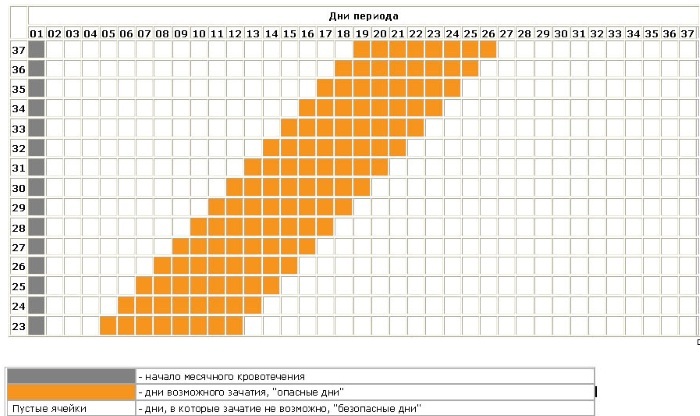
- From the shortest, 18 days are subtracted and the 1st fertile day is obtained.
- 11 days are subtracted from the longest cycle, thus determining the last number of the fertile window.
According to the state of cervical secretion
On fertile days, the vaginal secretion changes in its quantity and character. During this period, the discharge becomes clearer and more abundant. In this state, they are conducive to the advancement of sperm within the female body. The viscous nature of mucus remains until the end of ovulation. Discharge to this state is caused by a hormone that loosens and softens the cervix.
By measuring basal temperature
For a more accurate determination of the fertility window, the rectal temperature, the so-called basal temperature, is measured for several months. They do this when they wake up in the morning.
The information received is filled in a table, which will then be more convenient to navigate. At the end of menstruation, basal temperature readings usually do not exceed 36.9 °. With the arrival of the ovulation period, the value tends to increase by 1 °.
To collect more accurate readings, the temperature is measured, without getting out of bed, with a single thermometer, at the same time. But this method of determining ovulation can only be used by those who have a regular cycle.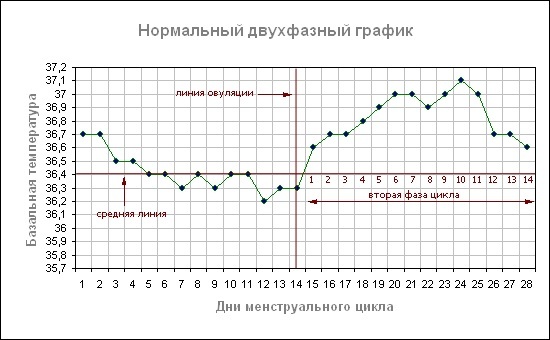
The fertility window is 5 days before ovulation and another 1 day after it. This amount of time is determined not only by the female egg, but also by the male sperm. After all, the duration of his life inside the female body in some cases can reach up to 5-6 days.
Using ultrasound results
With the help of ultrasound, they learn about the onset of the fertility window, as well as about its stage. Diagnostics are usually scheduled 10 days after the start of the cycle. When it is carried out, the growth of the follicle in the ovary is monitored. Having reached 20 mm in size, it breaks, and the egg begins to move towards the uterus.
Based on the results of an ultrasound of the ovaries, the doctor makes a fertility prognosis, which is measured by points, namely:
- +2 - speaks of high reproductive capacity;
- 0 - indicates normal fertility;
- -2 - defines low fertility.
The first 2 indications for women are satisfactory, but with the latter, infertility treatment and the help of specialists are required. Lost fertility is completely recoverable in most cases.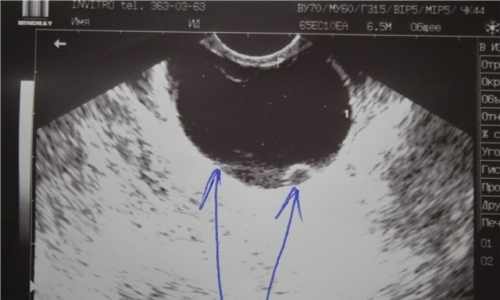
It is usually returned with:
- elimination of the causes of infertility;
- prescribing dietary supplements or vitamins;
- special treatment with ovulatory stimulants.
The fertility window is a designation of the time when the female body is able to reproduce offspring. It is this period that is most optimal in order to get pregnant. Fertilization of the egg occurs during its highest activity, more precisely, at the time of ovulation.
Fertile women get pregnant easily even if:
- the use of any contraceptives;
- lactation;
- recent abortion and childbirth;
- menstruation;
- defloration.
The fertile window in highly fertile women closes for a very short time, which means that they can conceive at any time. The reproductive age of such individuals will be
When examining infertility, doctors:
- check the hormonal level in the blood;
- an ovulation test is performed;
- determine the number of follicles in the ovaries;
- the fertility index is measured by menstrual flow, which contains a protein called alpha-2-microglobulin.
The hormones tested in women include:
- progesterone;
- luteinizing;
- anti-Müllerian hormone;
- estradiol;
- follicle-stimulating.
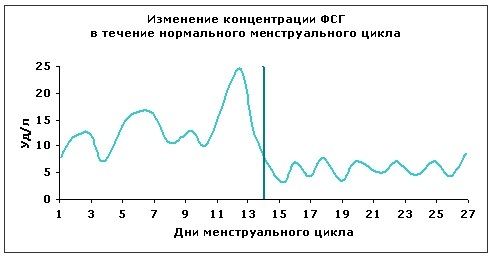
An increased level of follicle-stimulating hormone indicates good fertility, while a decreased level indicates poor fertility. Luteinizing hormone remains high during ovulation.
Patients with low fertility are prescribed concomitant therapy to improve their reproductive function. Such treatment should aim to eliminate factors that reduce fertility.
According to the following table, you can determine the possibility of fetal engraftment in different periods:
| Cycle time | Probable implantation percentage |
| 3-5 days | 0,2-0,8 |
| 5-7 days | 1-6 |
| 8-9 days | 20-40 |
| 10-12 days | 7-3 |
To improve female fertility:
- exclude traumatic factors and bad habits;
- lead an active lifestyle;
- switch to a balanced diet and regular drinking regime;
- give up fasting and low-calorie diets;
- are constantly sexually active (up to 2 times a week);
- ovulation stimulants are taken as prescribed by a doctor;
- choose the correct contraception as much as possible and refuse abortion.
The following will also help to improve the level of fertility during pregnancy planning:
- refusal from strong tea and pain medications;
- reasonably dosed physical activity;
- adequate nutrition;
- vitamins B and C;
- tocopherol;
- folic acid;
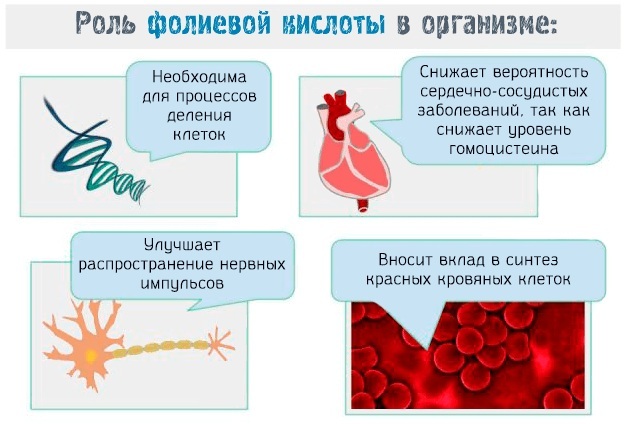
- selenium;
- pregnoton;
- magnesium;
- tribestan;
- zinc;
- ovariamine;
- rotted;
- clomiphene;
- metrodin;
- clostilbegit.
Ovulation stimulants and hormonal agents must be taken under the supervision of a doctor and only according to his prescriptions. Self-treatment of low fertility with such drugs is categorically contraindicated. Only vitamins and microelements do not require a doctor's prescription.
The window that determines the favorable time for conceiving a child includes not only the day of ovulation, but also the numbers adjacent to it. If, for example, the release of an egg falls in the middle of the menstrual cycle, then 12-16 days of the month will enter the fertile phase. This period of time is considered to be the guaranteed path to pregnancy.
Female fertility is directly dependent on male. Therefore, it is very important that the fertility of the partner is also at its best.
To improve it, men need:
- stop carrying your phone in pockets at testicular level;
- more often be in the fresh air;
- do physical education;
- give up underwear that is embarrassing to the body;
- take minerals and vitamins;
- avoid hypothermia of the testicles.
The quality of sperm is very badly affected by the abuse of smoking and alcoholic beverages. Because of this, male germ cells lose their vitality and acquire pathogenicity. Long-term use of medications can lead to dysfunction of the penis and testicles.
Testosterone, which affects fertility in both sexes, should be slightly increased in men and decreased in women.
Among the reasons affecting male reproductive performance are:
- modern food;
- long drug treatment;
- deficiency of trace elements and other nutrients;
- addictions;
- harmful professional environment;
- unfavorable ecology;
- lack of water in the body;
- overheating of the testicles in saunas and baths;
- prolonged inflammation of the body;
- severe chronic diseases;
- injured genitals;
- excess body weight;
- genitourinary diseases;
- stress;
- age.
After the onset of the fertile window, women are advised to:
- have unprotected sexual contact with your partner once every 2 days;
- after intercourse, lie down calmly with your legs up;
- abandon douching and artificial lubricants;
- exclude caffeine and dark chocolate from consumption.
The guaranteed onset of pregnancy may depend on more than just the fertile level of men and women. When trying to conceive a child, a certain period of time, also called a window, is also taken into account. This period determines the high probability of egg fertilization.
Fertility videos
Fertile days and pregnancy:

